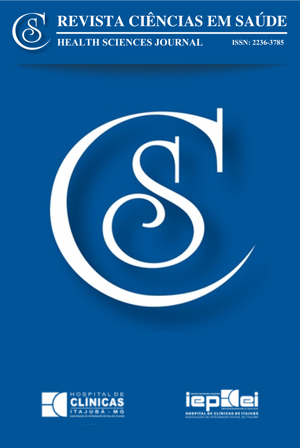Prevalence of IgM and IgG anti-Toxoplasma gondii antibodies in university students from the Biological Sciences Course, Pontal do Triângulo Mineiro
Main Article Content
Abstract
Objective: To investigate the presence of anti-Toxoplasma gondii IgM and IgG in the serum of Biological Sciences students at the Federal University of Uberlândia, Pontal campus. Methods: Cross-sectional prevalence study with data collection was conducted between June 2017 and February 2018. Indirect immunofluorescence and enzyme-linked immunosorbent assay (ELISA) techniques were used, and semi-structured questionnaires were used to assess previous knowledge abouttoxoplasmosis. Results: 128 students aged 18 to 41 years participated in the study, 83 (64.4%) female and 45 (35.6%) male. Blood samples were collected from 106 participants, and 13 (12.3%) had anti-T gondii antibodies. Of these, 3 (2.8%) claimed to consume unpasteurized bovine milk, 3 (2.8%) raw or undercooked meat, and 1 (0.94%) raw or unhygienic vegetables. There was no statistically significant association between positivity (IgM anti-T. gondii or IgG anti-T. gondii) and the variables analyzed in the questionnaire. Conclusion: In this work, it was possible to verify the presence of IgM and IgG anti-T gondii antibodies in university students. There was no association between seropositivity and eating habits. However, the questionnaire response analysis showed risky behavior on these individuals, especially concerning frequent contact with dogs and cats, often collected on the street.
Article Details
Authors maintain copyright and grant the HSJ the right to first publication. From 2024, the publications wiil be licensed under Attribution 4.0 International 
 , allowing their sharing, recognizing the authorship and initial publication in this journal.
, allowing their sharing, recognizing the authorship and initial publication in this journal.
Authors are authorized to assume additional contracts separately for the non-exclusive distribution of the version of the work published in this journal (e.g., publishing in an institutional repository or as a book chapter), with acknowledgment of authorship and initial publication in this journal.
Authors are encouraged to publish and distribute their work online (e.g., in institutional repositories or on their personal page) at any point after the editorial process.
Also, the AUTHOR is informed and consents that the HSJ can incorporate his article into existing or future scientific databases and indexers, under the conditions defined by the latter at all times, which will involve, at least, the possibility that the holders of these databases can perform the following actions on the article.
References
Dubey JP. Toxoplasmosis - a waterborne zoonosis. Veterinary parasitology. 2004;126(1-2):57-72. https://doi.org/10.1016/j.vetpar.2004.09.005 PMid:15567579
Zajdenweber M, Muccioli C, Belfort R Jr. Acometimento ocular em pacientes com AIDS e toxoplasmose do sistema nervoso central: antes e depois do HAART. Arq Bras Oftalmol. 2005;68(6):773-5. https://doi.org/10.1590/s0004-27492005000600012 PMID: 17344978
Luft BJ, Remington JS. Toxoplasmic encephalitis in AIDS. Clin Infect Dis. 1992;15(2):211-22. https://doi.org/10.1093/clinids/15.2.211 PMID:1520757.
Robert-Gangneux F, Dardé ML. Epidemiology of and diagnostic strategies for toxoplasmosis. Clin Microbiol Rev. 2012;25(2):264-96. https://doi.org/10.1128/cmr.05013-11. Erratum in: Clin Microbiol Rev. 2012;25(3):583. PMID:22491772 PMCID:PMC3346298
Yamamoto YI, Mourad AM, Prescendo FR, Ribeiro KS, Oliveira CB, Garcia RSL. Seroepidemiological survey of Toxoplasma gondii infection among students of a university. Rev Bras An Clin [Internet]. 2009 [cited 2020 Nov 24];41(4):299-302. Avaiable from: http://www.rbac.org.br/wp-content/uploads/2016/08/RBAC_Vol41_n4-Completa.pdf
Maia LP, Oliveira KR, Ferreira GLS, Gómez-Hernández C, Nomeline QSS, Aidar FLM. The prevalence of toxoplasmosis in the Pontal of the Triângulo Mineiro region, Minas Gerais State, Brazil. Rev Patol Trop. 2012;41(4):457-64. https://doi.org/10.5216/rpt.v41i4.21707
Guimarães AM, Ribeiro MFB, Lima JD, Cury MC, Spiewak G. Freqüência de anticorpos anti-Toxoplasma gondii em cães de Belo Horizonte, Minas Gerais. Arq Bras Med Vet Zootec. 1992;44(67-68).
Rodrigues JP, Frei F, Navarro IT, Silva LP, Marcelino MY, de Andrade-Junior HF, de Faria CA, Santos M, Ribeiro-Paes JT. Seroepidemiological analysis of toxoplasmosis in college students. J Venom Anim Toxins Incl Trop Dis. 2015;21(1):1. https://doi.org/10.1186/1678-9199-21-1 PMID:25587248 PMCID:PMC4293106.
Obaid HM. Survey study on toxoplasmosis among Kirkuk university students. J Univer Kerbala [Internet]. 2017 [cited 2020 Nov 24];13(1):253-9. Avaiable from: https://kj.uokerbala.edu.iq/article_123452.html
Passos ADC, Bollela VR, Furtado JMF, Lucena MM, Bellissimo-Rodrigues F, Paula JS, et al. Prevalence and risk factors of toxoplasmosis among adults in a small Brazilian city. Rev Soc Bras Med Trop. 2018;51(6):781-7. https://doi.org/10.1590/0037-8682-0214-2017 PMID: 30517531
Egorov AI, Converse R, Griffin SM, Styles J, Klein E, Sams E, et al. Environmental risk factors for Toxoplasma gondii infections and the impact of latent infections on allostatic load in residents of Central North Carolina. BMC Infec Dis. 2018;18(1):421. https://doi.org/10.1186/s12879-018-3343-y PMid:30139351 PMCid:PMC6108134
Garcia JL, Navarro IT, Ogawa L, Oliveira RC. Seroprevalence of Toxoplasma gondii in swine, bovine, ovine and equine, and their correlation with human, felines and canines, from farms in north region of Paraná state, Brazil. Cienc Rural. 1999;29(1):91-7. https://doi.org/10.1590/S0103-84781999000100017
Amendoeira MRR, Camillo-Coura LF. Brief review on toxoplasmosis in pregnancy. Sci Med [Internet]. 2010 [cited 2020 Nov 24];20(1):113-9. Avaiable from: https://revistaseletronicas.pucrs.br/ojs/index.php/scientiamedica/article/view/5917/4953
Leão PRD, Meirelles-Filho J, Medeiros SF. Toxoplasmosis: seroprevalence in postpartum women attended by SUS (Brazilian Public Health System). Rev Bras Ginecol Obstet. 2004;26(8):627-32. https://doi.org/10.1590/S0100-72032004000800006
Omata Y, Igarashi M, Ramos MI, Nakabayashi T. Toxoplasma gondii: antigenic differences between endozoites and cystozoites defined by monoclonal antibodies. Parasitol Res. 1989;75(3):189-93. https://doi.org/10.1007/bf00931274 PMID:2469081

